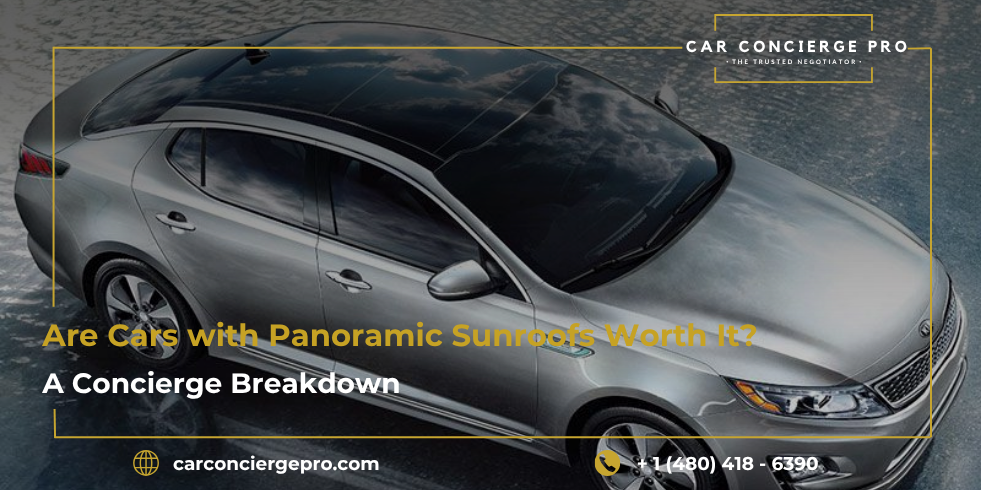Cars with panoramic sunroof feature an expansive glass panel—or series of panels—that cover a larger portion of the vehicle’s roof than traditional sunroofs. Unlike the conventional single-pane sunroof that only opens above the front seats, panoramic sunroofs often extend from the front to the rear, offering an open-air experience for both front and back passengers.
The panoramic glass roof is usually made from laminated, UV-resistant tempered glass. Many high-end cars with sunroof systems include retractable shades and motorized controls for better user experience. This kind of design elevates the aesthetics and perceived value of the vehicle, especially in luxury or mid-range segments.
While standard sunroofs may only provide ventilation, cars with panoramic sunroof offer enhanced visibility and a more immersive driving experience. Panoramic roof cars are designed for those who prioritize openness, natural light, and style, setting them apart from basic sunroof-equipped vehicles.
Table of Contents
ToggleThe Pros of Owning Cars with Panoramic Sunroof
Enhanced Cabin Ambience and Natural Lighting
One of the most immediate benefits of panoramic sunroof cars is the influx of natural light into the cabin. This openness makes the space feel larger, brighter, and more premium—factors that significantly improve passenger satisfaction during long drives.
Increased Vehicle Appeal and Resale Value
Cars with panoramic sunroof are typically more desirable on the resale market. A panoramic roof adds luxury appeal, which can increase trade-in value, especially for compact SUVs, crossovers, and premium sedans.
Better Driving Experience for Passengers
From stargazing on road trips to enjoying the skyline during city drives, the experience offered by a panoramic glass roof is unmatched. Rear passengers especially enjoy the extended view and openness, making family travel more enjoyable.
The Cons and Common Complaints About Panoramic Sunroofs
Potential for Leaks and Mechanical Failures
Despite the many benefits, panoramic sunroof cars can face issues like water leaks, especially if drainage channels clog or seals degrade over time. Repairs can be costly due to the complexity of the system.
Higher Interior Temperatures
Cars with sunroof tend to absorb more heat, particularly under intense sun. Even with UV-blocking technology, panoramic sunroofs can increase cabin temperature, necessitating greater use of air conditioning.
Increased Vehicle Weight and Reduced Efficiency
The added glass panel structure contributes to a heavier vehicle, slightly impacting fuel efficiency. For fuel-conscious buyers, this might be a deal-breaker despite the added visual appeal of panoramic roof cars.
Safety Concerns and Structural Integrity
Crash Safety and Reinforcement Standards
Automakers reinforce cars with panoramic sunroof to comply with rollover safety standards. However, the absence of a full metal roof may lead to concerns about long-term structural integrity, especially in older models.
Shattering Risks and Glass Quality
While rare, there have been reported cases of spontaneous shattering in panoramic glass roofs. These incidents, though infrequent, are often attributed to extreme temperature fluctuations or manufacturing flaws.
Maintenance of Sunroof Mechanisms
Cars with sunroof features require regular maintenance to avoid mechanical jams or malfunctioning shades. Dust and debris can interfere with motorized parts, emphasizing the need for proper upkeep in panoramic sunroof systems.
Impact on Driving Experience and Mood
Psychological Benefits of Open Cabin Design
Psychologists suggest that open spaces contribute to lower stress levels. Panoramic sunroof cars leverage this concept by offering a less claustrophobic, more mentally refreshing environment.
Noise and Wind Considerations
Despite acoustic dampening technologies, some panoramic roof cars may exhibit increased wind noise when opened. Understanding when and how to use the panoramic sunroof efficiently is key to a quieter ride.
Driving Visibility and Rear-Passenger Comfort
Natural lighting from panoramic sunroofs aids in overall visibility. Rear passengers benefit significantly as they typically get limited exposure to outside views in conventional sunroof-equipped vehicles.
Energy Efficiency and Air Circulation
Ventilation Without AC Dependence
Cars with sunroof options allow for better ventilation during cooler days. Opening the panoramic sunroof partially helps circulate air efficiently without turning on the AC, reducing fuel or battery usage.
Solar Gain and Cabin Temperature Control
Even with modern tints, panoramic glass roof structures lead to more solar gain. Some models include solar-reflective coatings, which are essential in minimizing heat buildup inside sunroof-equipped vehicles.
Top Cars with Panoramic Sunroof in 2025
Affordable Options with Panoramic Roof
Popular 2025 models like the Hyundai Tucson, Kia Sportage, and Ford Escape offer panoramic sunroof in mid-tier trims, providing an accessible entry point into the segment.
Luxury Vehicles Leading the Way
High-end brands like Mercedes-Benz, BMW, and Audi incorporate panoramic glass roofs as standard or optional features in most of their lineups. The Tesla Model Y and Lucid Air also stand out among electric panoramic sunroof cars.
EVs and Hybrids with Panoramic Sunroof
More electric vehicles now feature glass roofs to maximize openness while preserving aerodynamics. Models like the Toyota bZ4X and Ford Mustang Mach-E combine sustainability with style.
Is a Panoramic Sunroof Worth the Extra Cost?
Cost vs. Benefit Analysis
Cars with panoramic sunroof may carry a price premium of $1,000–$2,500 depending on the trim level. Buyers need to assess whether the added luxury, natural light, and resale value offset this investment.
Ownership Lifestyle and Driving Habits
For urban drivers or road trip enthusiasts, a panoramic sunroof enhances daily enjoyment. However, if you live in a hot climate or park under direct sunlight, a standard roof may serve you better.
Personal Preference Matters Most
Ultimately, the value of panoramic roof cars is subjective. For some, it’s a must-have; for others, it’s an unnecessary luxury. Evaluate how much you prioritize open skies over practical performance.
Maintenance Tips for Panoramic Sunroof Owners
Regular Inspection and Cleaning
Check the seals, tracks, and glass for debris or wear. Use soft microfiber cloths and avoid abrasive cleaners to maintain the clarity and function of your panoramic sunroof.
Lubrication and Mechanical Checks
Sunroof mechanisms need periodic lubrication. Inspect motor function and moving parts annually, particularly in older cars with sunroof systems, to prevent costly repairs.
Seasonal Maintenance Routines
In colder climates, ice and snow can block drainage or damage seals. Before winter, ensure your panoramic glass roof is watertight and operational to avoid seasonal damage.
Conclusion – Should You Buy a Car with a Panoramic Sunroof?
Cars with panoramic sunroof offer unmatched visual appeal, driving pleasure, and resale value. However, they also require extra care and come with minor drawbacks like heat absorption and maintenance.
If luxury, natural light, and aesthetics are priorities, a panoramic roof is a worthwhile addition. For practical buyers focused on efficiency and durability, it might not be essential.
Before you buy, test drive a few panoramic sunroof cars to experience the feature firsthand. Compare it to non-sunroof variants and see what aligns with your preferences. When you’re ready, consult your local dealer or explore certified panoramic sunroof vehicles online for the best deal.




 and Canada
and Canada 




